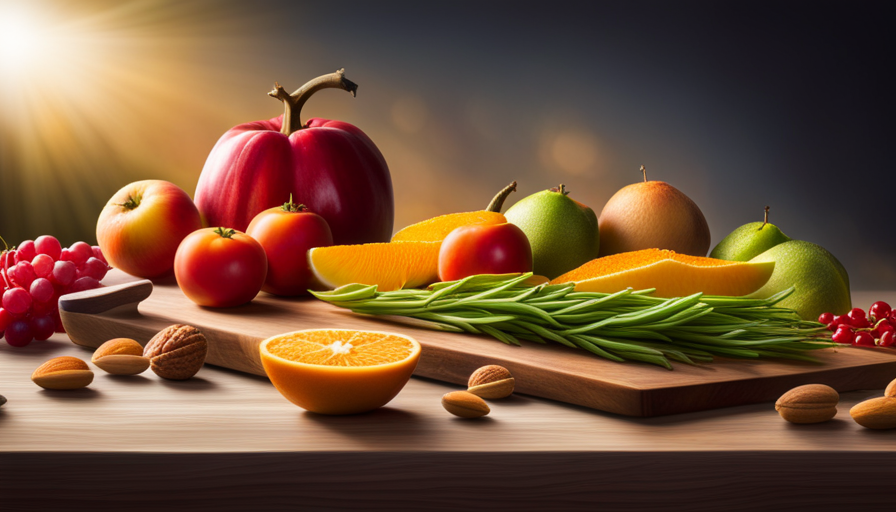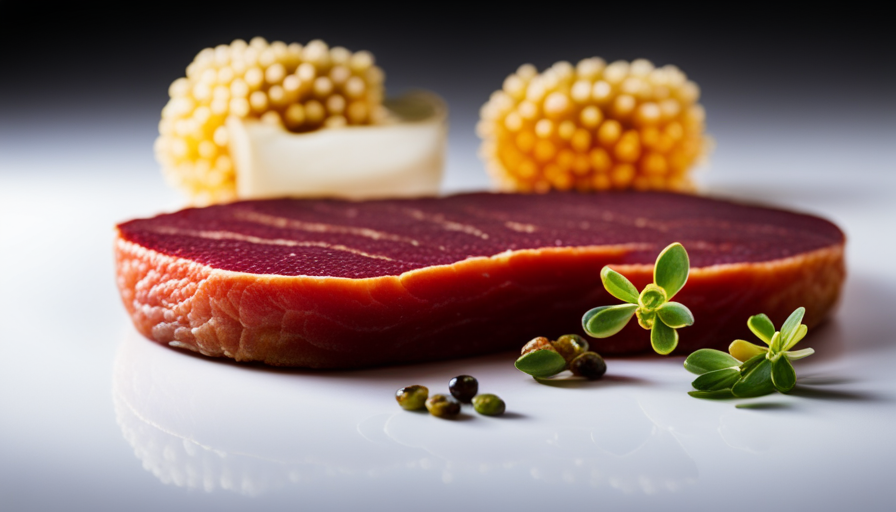Have you heard about the various health benefits of adding raw food to your diet? A recent study shows that incorporating raw foods can lead to better digestion, increased energy, and improved overall well-being.
But what exactly counts as raw food? In this article, I will provide a comprehensive guide to help you understand what falls under the category of raw food. We will explore:
- Uncooked fruits and vegetables
- Raw nuts and seeds
- Raw dairy and eggs
- Raw meat and seafood
- Raw juices and smoothies
- Raw sprouts and microgreens
Additionally, we will debunk common misconceptions about raw food and discuss how to incorporate these nutritious options into your daily meals. Whether you’re a seasoned raw food enthusiast or just starting to explore this lifestyle, this article will provide you with the knowledge and tools needed to make informed choices for a healthier, more vibrant life.
Key Takeaways
- Raw food refers to uncooked or unprocessed food.
- Raw food is rich in enzymes, vitamins, minerals, and antioxidants.
- Proper washing of raw fruits and vegetables is crucial to avoid harmful bacteria.
- Raw nuts and seeds are nutrient powerhouses, rich in healthy fats, protein, fiber, vitamins, and minerals.
The Definition of Raw Food
Do you ever wonder what qualifies as raw food and how it can benefit your overall health? Well, let’s dive into the definition of raw food and explore its potential benefits and risks.
Raw food refers to any food that hasn’t been cooked or processed at high temperatures. This includes fruits, vegetables, nuts, seeds, and even some animal products like raw milk or cheese. Many people choose to follow a raw food diet because it’s believed to provide several health benefits.
For starters, raw food is rich in enzymes, which are essential for digestion and nutrient absorption. Additionally, raw food is packed with vitamins, minerals, and antioxidants, all of which contribute to a strong immune system and vibrant health.
However, it’s important to note that there are potential risks associated with consuming raw food. Raw food can sometimes harbor harmful bacteria, such as Salmonella or E. coli, which can cause foodborne illnesses. Therefore, it’s crucial to handle and prepare raw food with care.
In the subsequent section, we will explore the benefits of uncooked fruits and vegetables without skipping a beat.
Uncooked Fruits and Vegetables
Fresh fruits and vegetables, like vibrant jewels plucked from nature’s garden, offer a burst of flavor and nutrition when enjoyed uncooked. Eating raw fruits and vegetables has numerous benefits.
Firstly, they are rich in essential vitamins, minerals, and antioxidants that are often lost during cooking. These nutrients play a crucial role in boosting our immune system, promoting healthy skin, and reducing the risk of chronic diseases.
Additionally, uncooked produce retains its natural enzymes, which aid in digestion and nutrient absorption. Moreover, consuming raw fruits and vegetables can help with weight management due to their high fiber content, which promotes feelings of fullness and reduces calorie intake.
However, it is important to be aware of the potential risks of consuming raw produce. Raw fruits and vegetables can harbor harmful bacteria, such as E. coli and Salmonella, especially if not properly washed. These bacteria can cause foodborne illnesses and pose a greater risk for vulnerable populations, such as young children, pregnant women, and individuals with weakened immune systems. Therefore, it is crucial to thoroughly wash and handle raw fruits and vegetables to minimize the risk of contamination.
Transitioning to the subsequent section about raw nuts and seeds, they too offer a range of health benefits when consumed in their uncooked form.
Raw Nuts and Seeds
Indulge in the irresistible crunch and nutty goodness of uncooked nuts and seeds – they’re packed with essential nutrients and offer a delightful snacking experience! Here are some benefits of consuming raw nuts and seeds:
-
Nutrient Powerhouse: Raw nuts and seeds are rich in healthy fats, protein, fiber, vitamins, and minerals. They provide a wide range of nutrients that support overall health and well-being.
-
Heart Health: The monounsaturated and polyunsaturated fats found in raw nuts and seeds can help reduce bad cholesterol levels, lower the risk of heart disease, and improve cardiovascular health.
-
Weight Management: Despite their high fat content, raw nuts and seeds can actually aid in weight management. The combination of healthy fats, protein, and fiber helps promote satiety and prevent overeating.
-
Versatile Ingredient: Incorporating raw nuts and seeds into recipes is easy and adds a delicious nutty flavor and crunchy texture. They can be sprinkled on salads, blended into smoothies, used as a topping for yogurt or oatmeal, or ground into a nutritious nut butter.
Transitioning into the next section about raw dairy and eggs, exploring the benefits of consuming these raw foods provides further insight into the world of raw food nutrition.
Raw Dairy and Eggs
Discover the incredible benefits of incorporating raw dairy and eggs into your diet – can you imagine the creamy goodness and endless possibilities these nutritious ingredients can bring to your meals?
Raw dairy and eggs offer a wide range of nutritional benefits. They are excellent sources of protein, essential amino acids, vitamins, and minerals. Raw dairy products, such as raw milk and cheese, contain enzymes and beneficial bacteria that aid in digestion and support a healthy gut. Raw eggs are packed with nutrients like vitamin B12, folate, and choline, which are essential for brain health and development.
However, it’s important to address safety concerns when consuming raw dairy and eggs. Raw dairy products may contain harmful bacteria like Salmonella, E. coli, and Listeria, which can lead to foodborne illnesses. Pregnant women, young children, the elderly, and individuals with weakened immune systems should avoid consuming raw dairy and eggs due to the increased risk of infection.
It’s crucial to source raw dairy and eggs from reputable, trusted sources that follow strict hygiene and safety protocols.
Transitioning to the next section, let’s now explore the topic of raw meat and seafood, where we’ll discover the benefits and safety considerations of incorporating these raw foods into our diets.
Raw Meat and Seafood
Are you ready to experience the tantalizing flavors and health benefits that come with incorporating raw meat and seafood into your diet? While it may seem unconventional to consume these foods without cooking them, there are cooking methods specifically designed for raw meat and seafood that ensure their safety and enhance their taste. For example, ceviche is a popular dish where raw seafood is marinated in citrus juices, effectively "cooking" the meat with the acidity. Another method is tartare, where raw meat is finely chopped and seasoned with herbs and spices. These techniques preserve the natural flavors and textures of the ingredients, offering a unique culinary experience.
Consuming raw meat and seafood can have several health benefits. Raw meat is a good source of essential nutrients such as proteins, vitamins, and minerals. It also contains enzymes that aid in digestion and absorption of nutrients. Additionally, raw seafood, like sushi and sashimi, is rich in omega-3 fatty acids, which have been linked to numerous health benefits including reduced inflammation and improved heart health.
Transitioning into the subsequent section about ‘raw fermented foods’, it’s fascinating to explore how different food preparation techniques can enhance not only the taste but also the nutritional value of our meals.
Raw Fermented Foods
Transitioning into the subsequent section, it’s intriguing to explore the ways in which various culinary techniques can elevate both the flavor and nutritional value of our meals, such as with raw fermented foods. Fermentation has been used for centuries to preserve and enhance the taste of foods.
Here are three reasons why incorporating raw fermented foods into your diet can be beneficial:
-
Improved Digestion: Fermented foods are rich in probiotics, which are beneficial bacteria that promote a healthy gut. These probiotics help break down food and aid in nutrient absorption, leading to better digestion and improved overall gut health.
-
Enhanced Nutrient Content: The fermentation process increases the bioavailability of certain nutrients, making them easier for our bodies to absorb. For example, fermented vegetables like sauerkraut and kimchi are packed with vitamins, minerals, and antioxidants, making them a nutritious addition to any meal.
-
Boosted Immune System: The probiotics found in fermented foods can help support a strong immune system. They stimulate the production of immune cells and regulate inflammation, which can help protect against infections and promote overall immune health.
Understanding the benefits of raw fermented foods can inspire us to incorporate them into our diet more often.
Speaking of nourishing and refreshing options, let’s dive into the world of raw juices and smoothies in the next section.
Raw Juices and Smoothies
Get ready to indulge in a refreshing and flavorful treat with raw juices and smoothies, as they provide a delicious way to boost your health and vitality.
Raw juices are made from fresh fruits and vegetables, which retain their natural enzymes and nutrients since they’re not exposed to heat during the juicing process. This allows your body to easily absorb the vitamins, minerals, and antioxidants present in these raw concoctions. Drinking raw juices can have numerous benefits, such as improving digestion, enhancing immune function, and increasing energy levels.
When it comes to raw smoothies, the key is to use the best ingredients to maximize their nutritional value. Opt for a variety of fresh, organic fruits and vegetables to ensure you’re getting a wide range of vitamins and minerals. Leafy greens like kale and spinach are excellent choices, as they’re packed with antioxidants and fiber. Adding superfoods such as chia seeds, hemp seeds, or spirulina can further enhance the nutritional content of your smoothies.
Now, let’s transition into the subsequent section about raw sprouts and microgreens.
Raw Sprouts and Microgreens
Make sure you include raw sprouts and microgreens in your diet as they provide a powerful nutritional punch, with microgreens containing up to 40 times more nutrients than their mature counterparts. These tiny greens are packed with vitamins, minerals, and antioxidants, making them a fantastic addition to any meal.
Here are three reasons why you should incorporate raw sprouts and microgreens into your daily routine:
-
Supercharged Nutrition: Raw sprouts and microgreens are bursting with nutrients. They’re rich in vitamins A, C, and K, as well as minerals like iron and potassium. These nutrients play a crucial role in supporting a healthy immune system, promoting good vision, and maintaining strong bones.
-
Easy to Grow: Growing sprouts and microgreens at home is a simple and cost-effective way to boost your nutrient intake. They require minimal space, time, and effort. Within a week, you can have fresh and vibrant sprouts or microgreens ready to harvest and enjoy.
-
Health Benefits of Microgreens: Microgreens aren’t just delicious but also offer a range of health benefits. Studies have shown that they may help reduce the risk of chronic diseases, such as heart disease and certain types of cancer. They’re also known to have anti-inflammatory properties and can support digestion.
As we move on to discuss common misconceptions about raw food, it’s important to understand the incredible benefits that raw sprouts and microgreens can provide.
Common Misconceptions About Raw Food
Discover the truth behind the myths surrounding the power-packed benefits of incorporating raw food into your diet. Many people believe that a raw food diet is the key to optimal health. While there are certainly health benefits associated with consuming raw food, it’s important to understand the potential risks and drawbacks as well.
Proponents of a raw food diet claim that it can lead to increased energy levels, improved digestion, and enhanced nutrient absorption. Raw foods are rich in enzymes, which are essential for digestion and can support overall gut health. Additionally, raw fruits and vegetables are packed with vitamins, minerals, and antioxidants that can boost the immune system and promote overall health.
However, it’s crucial to note that there are potential risks associated with consuming raw food. Raw foods, especially animal products, can harbor harmful bacteria such as Salmonella and E. coli. These bacteria can cause foodborne illnesses and lead to serious health complications. It’s important to practice proper food safety measures when consuming raw food, such as washing fruits and vegetables thoroughly and storing them at the correct temperature.
Incorporating raw food into your diet can be a great way to increase your intake of nutrient-dense foods. However, it’s essential to be aware of the potential risks and take necessary precautions to ensure food safety. By understanding the benefits and drawbacks of a raw food diet, you can make informed decisions about incorporating raw food into your daily meals.
Incorporating Raw Food into Your Diet
Savor the succulent satisfaction of incorporating fresh, uncooked ingredients into your diet to supercharge your health and happiness. Here are four reasons why incorporating raw food into your diet is a great idea:
-
Raw food recipes: There’s a wide variety of delicious raw food recipes available that can add excitement to your meals. From refreshing salads packed with colorful veggies to nutrient-rich smoothies, there are endless possibilities to explore.
-
Health benefits of incorporating raw food into your diet: Raw foods retain their natural enzymes and nutrients, which can provide numerous health benefits. They include improved digestion, increased energy levels, enhanced immune function, and better skin health. Raw foods are also rich in fiber, antioxidants, and essential vitamins and minerals, promoting overall well-being.
-
Increased nutrient intake: Cooking can cause the loss of some nutrients in food. By incorporating raw food into your diet, you can maximize your nutrient intake. Raw fruits and vegetables are especially high in vitamins, minerals, and phytochemicals, which can support optimal health.
-
Weight management: Raw foods are generally low in calories and high in fiber, making them an excellent choice for weight management. They can help you feel fuller for longer, reduce cravings, and support healthy weight loss or maintenance.
Incorporating raw food into your diet can be a flavorful and nutritious way to enhance your overall well-being. So, why not give it a try and enjoy the benefits of these fresh, uncooked ingredients?
Frequently Asked Questions
Are there any specific safety guidelines to follow when consuming raw food?
Yes, there are specific safety guidelines to follow when consuming raw food to prevent foodborne illnesses. It is important to thoroughly wash all fruits and vegetables before consuming them. Additionally, it is recommended to cook meat, poultry, and seafood to their proper internal temperatures to kill any harmful bacteria. Avoid cross-contamination by using separate cutting boards and utensils for raw and cooked foods. Lastly, refrigerate perishable raw foods promptly to prevent bacterial growth. Adhering to these safety guidelines can greatly reduce the risk of foodborne illnesses.
Can raw food be cooked or heated in any way without losing its nutritional value?
Yes, raw food can be cooked or heated without losing its nutritional value, depending on the cooking methods used. Research suggests that certain cooking methods, such as steaming, boiling, and stir-frying, can help retain the nutritional benefits of raw food. These methods preserve the vitamins, minerals, and antioxidants present in the food. However, overcooking or prolonged exposure to high heat can degrade the nutritional content. Therefore, it’s important to choose cooking methods that minimize nutrient loss.
How can I ensure that I am getting all the necessary nutrients from a raw food diet?
To ensure I’m getting all the necessary nutrients from a raw food diet, I follow a simple allegory: I imagine my body as a garden that needs a variety of seeds to thrive. I focus on ensuring nutrient balance by including a diverse range of fruits, vegetables, nuts, and seeds in my meals.
Raw food meal planning plays a crucial role, as I carefully select and combine ingredients to meet my nutritional needs. This approach helps me maintain a healthy and vibrant garden within my body.
Are there any potential health risks associated with consuming raw food?
There are potential health risks associated with consuming raw food, particularly in terms of foodborne illnesses. Raw foods can harbor harmful bacteria and parasites that can cause infections and illness.
However, there are also benefits to consuming raw food, such as increased nutrient intake and improved digestion. It’s important to take proper precautions when consuming raw food, such as washing fruits and vegetables thoroughly and storing them properly to minimize the risk of foodborne illnesses.
Is it possible to obtain enough protein from a raw food diet?
I’m happy to tell you that it’s absolutely possible to obtain enough protein from a raw food diet! There are plenty of protein sources for a raw diet. These include nuts, seeds, leafy greens, and sprouted legumes. These foods provide essential amino acids that our bodies need to build and repair tissues. By incorporating a variety of these protein-rich foods into your raw diet, you can ensure that you’re meeting your protein needs while enjoying the benefits of a raw food lifestyle.
Are There Different Definitions of Raw Food?
Yes, there are different understanding raw food principles. Some people believe raw food means uncooked, while others interpret it as minimally processed. Ultimately, the definition of raw food varies among individuals and may be influenced by cultural, dietary, and health beliefs.
Conclusion
So there you have it, folks. After delving into the world of raw food, it’s clear that the definition can be quite broad. From uncooked fruits and vegetables to raw dairy and eggs, there are plenty of options to choose from.
And let’s not forget about the raw meat and seafood, juices and smoothies, and sprouts and microgreens. It’s truly a smorgasbord of possibilities.
So, if you’re looking to add a touch of sophistication to your diet, why not give raw food a try? You might just be surprised by the rawesome results.










